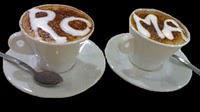 Tourists in Italy are easily recognizable in cafés and restaurants when they order a cappuccino after 11:00 a.m. or after a meal. Italians consider the cappuccino as a morning beverage. They gulp them down quickly while standing at the bar and then rush off to wherever it is they have to be so urgently. As a tourist or foreigner, there's no shame in taking your time to enjoy your warm, frothy cappuccino.
Tourists in Italy are easily recognizable in cafés and restaurants when they order a cappuccino after 11:00 a.m. or after a meal. Italians consider the cappuccino as a morning beverage. They gulp them down quickly while standing at the bar and then rush off to wherever it is they have to be so urgently. As a tourist or foreigner, there's no shame in taking your time to enjoy your warm, frothy cappuccino.I have often wondered why it is so difficult to find a good cappuccino outside of Italy. I mean, it's espresso and milk. It should be easy to make. I have also noticed that the best cappuccini (plural for cappuccino in Italian) are in Rome. It seems that as you travel further northward or southward from Rome, the quality of the cappuccini changes. Of course, it's all relative: in my view, even a bad cappuccino is good. I rarely encounter a cappuccino that I consider undrinkable.
 Outside of Italy, cappuccini may be made with different milk and coffee. But this doesn't explain the discrepancy within Italy. The coffee and milk are the same all over Italy. So perhaps it is the water used to make the espresso. Or could technique have something to do with it?
Outside of Italy, cappuccini may be made with different milk and coffee. But this doesn't explain the discrepancy within Italy. The coffee and milk are the same all over Italy. So perhaps it is the water used to make the espresso. Or could technique have something to do with it? When in Italy, I like to go to a bar called "Il Pappagallo" in Rome. Mario makes an exceptional cappuccino. His cappuccini are the smoothest and creamiest I have ever tasted. When I asked him what his secret is, he explained that there are a number of factors in creating a good cappuccino. A cappuccino is made by putting ground coffee into a small filter, pressing it down and putting it into the machine. The water filters through and drips out into the cup below as espresso. Milk is then frothed up using a steamer and poured into the espresso. Sounds simple enough. But it seems that there is more to it than that.
When in Italy, I like to go to a bar called "Il Pappagallo" in Rome. Mario makes an exceptional cappuccino. His cappuccini are the smoothest and creamiest I have ever tasted. When I asked him what his secret is, he explained that there are a number of factors in creating a good cappuccino. A cappuccino is made by putting ground coffee into a small filter, pressing it down and putting it into the machine. The water filters through and drips out into the cup below as espresso. Milk is then frothed up using a steamer and poured into the espresso. Sounds simple enough. But it seems that there is more to it than that. Mario says that you can spot an inexperienced barman by how much coffee he puts into the filter and how firmly he presses it down. Apparently, you should fill the filter with the ground coffee just to the top, not in a heaping mound, and press it down gently. If you use too much coffee, you have press it down harder and the water will not filter through fluidly, the end result being that it will taste too strong. The taste of the coffee will also be influenced by the temperature of the water. If the water is too hot, the ground coffee will also become too hot, thereby giving the espresso a burnt flavour. Finally, it takes a skilled and experienced barman to pour the foamy milk into the espresso. The foamier milk rises to the top after it is steamed, so the milk should be skilfully poured to add equal parts steamed milk from the bottom and frothy milk from the top. This third part can be tricky, but the Italians seem to have mastered this fine art.
Mario says that you can spot an inexperienced barman by how much coffee he puts into the filter and how firmly he presses it down. Apparently, you should fill the filter with the ground coffee just to the top, not in a heaping mound, and press it down gently. If you use too much coffee, you have press it down harder and the water will not filter through fluidly, the end result being that it will taste too strong. The taste of the coffee will also be influenced by the temperature of the water. If the water is too hot, the ground coffee will also become too hot, thereby giving the espresso a burnt flavour. Finally, it takes a skilled and experienced barman to pour the foamy milk into the espresso. The foamier milk rises to the top after it is steamed, so the milk should be skilfully poured to add equal parts steamed milk from the bottom and frothy milk from the top. This third part can be tricky, but the Italians seem to have mastered this fine art. 
Armed with this knowledge, I started to observe the techniques of cappuccino in my travels throughout Italy. There is definitely some truth in Mario's philosophy. I have noticed that (generally speaking of course) the farther north and south you get from Rome, the hotter they serve their cappuccino. They seem to prefer a stronger, slightly burnt tasting coffee. To each their own, right?

